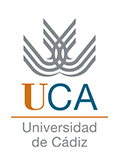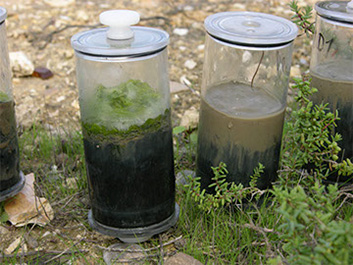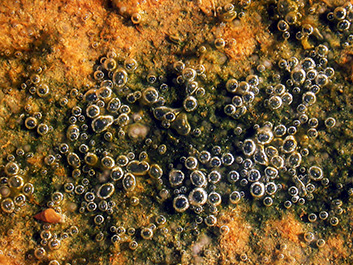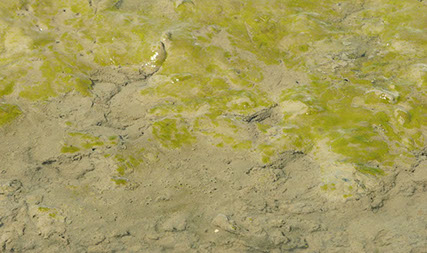Sediment plays an important role in the biogeochemical cycles of shallow aquatic environments like estuaries, coastal lagoons and mudflats. In such areas, a large fraction of the organic matter is produced and remineralized near the sediment-water interface. In addition, intertidal sediments can represent a large surface area in shallow environments. For instance, in the inner Bay of Cádiz, a good ecosystem model for southern Europe temperate estuarine zones, the intertidal zone represents 60 % of the total area. Therefore, the biogeochemical processes occurring in the sediment, as well as the interactions of the sediment with the water column, determine to a large extent the overall ecosystem dynamics.
The sediment-water interface is a complex biogeochemical system, characterized by sharp physicochemical gradients at very small scales, from µm to a few mm. Irradiance, concentration of O2 and other electron acceptors (e.g. NO3–, SO42-, Fe3+), pH, redox potential, organic moieties etc. change considerably with depth at the sediment-water interface. These changes at the microscale also affect the microbial community inhabiting the sediment surface.
Shallow coastal sediments, both intertidal and subtidal, are inhabited by a very complex and metabolically diverse microbial community consisting of photoautotrophic microalgae (mainly diatoms) and prokaryotes (cyanobacteria), autotrophic and heterotrophic prokaryotes (bacteria and archaea) and several types of protozoa. In turn, these microorganisms and the organic detritus accumulated in the sediment constitute the food resources for a taxonomically diverse community of small animals (50-500 µm) called collectively meiofauna. Finally, larger animals, macrofauna (>500 μm), feed upon the microbial and meiofaunal communities and organic detritus with different degrees of food selectivity.
The photoautotrophic component of the sediment microbial community, collectively called microphytobenthos (MPB), is highly productive and an important contributor to total primary production in estuaries and shallow environments. It therefore represents an important carbon source for benthic heterotrophs. In addition, the biological activities of MPB play an important role in the oxygen and nutrients availability near the sediment surface affecting the mineralization of organic matter and the cycling of elements. A major ecological interaction between MPB and the sediment habitat is via the production of extracellular polymeric substances (EPS), predominantly polysaccharides, which contribute to maintaining the physical integrity of the sediment surface and play an important role in carbon cycling within sediments.
Collaborations
Main collaborators from other labs include:
Niels Peter Revsbech, University of Aarhus, Denmark.
Graham Underwood, University of Essex, U.K.
Terry McGeneity, University of Essex, U.K.
Selected publications (more can be found here)
Corzo, A., Luzon, A., Mayayo, M. J., van Bergeijk, S. A., Mata, P., García de Lomas, J. (2005) Carbonate mineralogy along a biogeochemical gradient in recent lacustrine sediments of Gallocanta Lake (Spain). Geomicrob. J. 22: 283-298.
Pérez-Outeiral, F.J., M.P. Mata, E. García-Robledo, A. Corzo (2008). Cementación carbonatada cianobacteriana en un caño mareal del Parque Natural de la Bahía de Cádiz. Geo-Temas 10:1457-1460.
García-Robledo, E., Corzo, A., Papaspyrou, S., Jiménez-Arias, J. L., Villahermosa, D. (2010). Freeze Lysable Inorganic Nutrients in intertidal sediments: dependence on microphytobenthos abundance. Mar Ecol. Prog. Ser. 403: 155-163.
Papaspyrou S., Diz P., García Robledo E., Corzo A., Jimenez-Arias JL. (2013). Dynamics of benthic foraminifera in an intertidal area of Bahía de Cádiz (Spain). Marine Ecology Progress Series 409: 121-135.
García-Robledo, E., Corzo A., Papaspyrou S. (2014). An easy, fast and direct spectrophotometric method for the sequential determination of nitrate and nitrite at low concentrations in small volumes. Marine Chemistry (in press).
Funding
Ecological responses of microphytobenthos to the accumulation of nitrophilic macroalgae on intertidal sediments. Senescence and early diagenesis of the bloom, (Respuestas ecológicas del microbentos a la acumulación de macroalgas nitrófilas en sedimentos intermareales. Senescencia y diagénesis temprana del Bloom), CTM2006-04015/MAR, CICYT, Spain (110.957 €), PI: Prof. A. Corzo, 2006-2008.
Gestion environnementale des zones lagunaires à vocation aquacole (Gestión medioamabiental de zonas lagunares con vocación acuícola, ECOLAGUNES) SOE1/P2/F153. Interrg. Espacio SUDOE, UE. (220.075 euros), PI: Prof. I. Hernández (Subproyecto UCA), April 2009- April 2011.
Nitrogen removal in coastal sediments: molecular microbial ecology of nitrate reducing bacteria (PERG04-GA-2008-235005), EU (35.209 euros), PI: A. Corzo, Sept-2011- Sept 2012.
Microecology and changes in the biogeochemical cycles of C and N in intertidal sediment induced by macroalgae blooms (Microecología y cambios en los ciclos biogeoquímicos del carbono y del nitrógeno en sedimentos intermareales producidos por floraciones de macroalgas) (CTM2009-10736), CICYT Spain (256.520 euros), PI: A. Corzo, 2010- 2012.
Microecology and biogeochemistry of tidal flats in the Bay of Cádiz: Physical forcing by tidal cycle and photoperiod (Microecología y biogeoquímica de los sedimentos intermareales de la Bahía de Cádiz: Forzamiento físico por el ciclo mareal y el fotoperiodo) (CTM2013-43857-R). Spanish Interministerial Comission of Science and Technology (CICYT), PI: Prof. A. Corzo, Luis Mariscal (180,000€). 2014-2016






